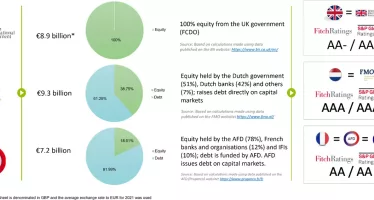Wealth on the Move: HNWIs Continually Searching for their Own Little Piece of Paradise
 There is continuous movement of wealth around the world. And the wealthy migrate both away from — and towards.
There is continuous movement of wealth around the world. And the wealthy migrate both away from — and towards.
Last year, high net worth individuals (a HNWI has personal net assets exceeding $1 million) in the emerging and frontier economies migrated, in particular, to the developed world and the top Anglo countries (except the UK, which lost HWWIs). The recipient countries benefitted from this imported wealth and human capital, while the developing world experienced loss of assets and brain drain.
The biggest winners were the liberal western democracies, while the losers were the more authoritarian governments such as China, Russia, and Turkey. Law-and-order countries with reliable institutions and good governance benefitted from an influx of rich people. Less institutionally strong countries, such as Lebanon, Nigeria and Venezuela, saw an exodus. In Europe, low-tax countries such as Switzerland, Monaco and Malta gained while higher taxing UK and France lost out. The world’s HNWIs continue to gravitate towards stand-out shining (but smaller) stars such as Monaco, Singapore, UAE and Mauritius.
The five wealthiest countries in the world — all with per-capita wealth of over US$175,000 vs the $24,000 world average — are Monaco, Luxembourg, Switzerland, Australia, and United States. They all saw a new influx of HNWIs last year.
A recent report, Global Wealth Migration Review, by wealth intelligence firm NWWealth (newworldwealth.com) and AfrAsia Bank (afrasiabank.com) examines recent worldwide wealth migration trends. AfrAsia Bank is a financial services provider with innovative solutions connecting Africa, Asia and the World using Mauritius as the gateway for investment.
The period covered in the report for the global rankings is 2019, i.e. before the pandemic. Andre Amoils, from NWWealth, the principal behind the research, says “the pandemic will most likely have slowed down migration this year.”
HNWIs can be divided into four bands: billionaires (>$1bn), centi-millionaires (>$100m); multi-millionaires (>$10m) and millionaires (>$1 million). Generally, mobility is mostly observed with tiers two and three above, as billionaires tend to roam little, regardless of their and politicians’ public threats. Millionaires cannot always afford uprooting. Billionaires may be quite comfortable, and the castle or mansion cannot travel, or they may be culturally tied-in from a multi-generational set-up — and rich enough to pay their taxes (or afford clever trust accountants).
HNWI’s motivation to change residence may have to do with moving away from current conditions or seeking new opportunities – or a combination of factors. In the words of the report, wealth migration figures are “a particularly important gauge of the health of an economy”.
It reads: “For instance, if a country is losing a large number of HNWIs to migration, it is probably due to serious problems in that country (i.e. crime, lack of business opportunities etc.).It can also be a sign of bad things to come as HNWIs are often the first people to leave — they have the means to leave, unlike middle-class citizens. If one looks at any major country collapse in history, it is normally preceded by a migration of wealthy people away from that country. Conversely, countries that attract HNWIs tend to be exceptionally healthy and normally have low crime rates, good schools and good business opportunities.”
The main reasons HNWIs travel often have to do with safety: escaping an oppressive government, crime, civil unrest or war. There are also financial concerns, including expropriation, extorsion and taxes.
Some wealthy people are drawn to a better lifestyle with improved climate (northerners seeking sun); less pollution (think China); and to enjoy space, nature and scenery (Greek attractions). Then again, HNWIs are also drawn towards work and business opportunities, better schooling, healthcare system, and education for their children as well as better standard of living (life in USA and Australia is great for multi-millionaires and the better-off).
Popular Destinations
Australia was the most popular country last year for HNWI inflow, with Sydney the dominating city of the world and Melbourne in the number three spot. There was also an influx to Brisbane, Perth, Gold Coast and the Sunshine Coast. Australia’s points-based immigration system favours business owners and professionals such as lawyers, accountants, doctors and engineers. No wonder Boris Johnson has advocated for such a system.
Australia with its 25 million inhabitants ticks plenty of boxes with its attractions: personal safety, low crime rates, climate, nature and scenery. There are good education options, it’s an English-speaking country (almost all HNWIs from around the world speak English as a first and second language). Australia also has a first-class healthcare system, unlike the US, which can be expensive and complicated. It’s one of the fastest-growing economies, and positioned next to surging South East Asian markets.
United States (#2 ranked) has for recent modern history been one of the most favoured destinations, and had a net inflow of 10,800 HNWIs. Many cities welcome HNWIs, including Houston, which also benefits from intra-US general and HNWI movement due to no state taxes; e.g. California has high-taxes (and homeless, crime and forest fires). Benefitting from foreign HNWs on the west coast are Los Angeles, San Francisco, Seattle (jobs and entrepreneurship) and the Silicon Valley region. On the east coast, chosen destinations are New York City, Boston and towns such as Greenwich.
The US is the world economic leader which dominates many sectors, including banking, asset management, technology, media, entertainment, education. The US also shares some of the attractions as Australia; Canada (#4) has seen the arrival of 2,200 HNWIs.
Switzerland (#3 ranked) has for decades been a haven for the well-off, with 4,000 HNWIs moving there last year, predominantly to Geneva, ranked city #2 after Sydney. Switzerland enjoys safety status and a high standard of living. It is the second-largest wealth management hub in terms of AuM. HNWIs can stay close to their money, which is convenient with new cross-border agreements.
This dynamic also attracted 1,500 HNWIs to Singapore, country #5 and city #4. Reads the study: “Singapore continues to attract HNWIs, mainly from the rest of Asia. Notably, Singapore is emerging as the top wealth management centre in Asia, which could assist in attracting many more HNWIs in the future.”
Dubai (city #5) has for some years been a chosen city for HNWIs and anybody who has been there will know why. It has futuristic architecture, smart organisation, and many attractions. About 85 percent of Dubai’s population is comprised of expats, so there is cultural diversity. The UAE is an appealing destination for wealth preservation and commerce.
Some southern European countries have benefitted from investor visa programmes, in particular Portugal, Greece and Malta. Tiny Monaco still enjoy inflows of 100+ HNWIs per annum.
Mauritius enjoys comparable influx. It has attracted a steady stream of HNWIs over the past decade, perhaps due to the ease of doing business there. Mauritius ranks first in Africa and 13th worldwide in the World Bank’s 2020 ‘Doing Business’ report. Mauritius is also known for safety and a fast-growing financial services sector. The country is now home to around 4,000 HNWIs (as of June 2020), compared to 2,500 a decade ago.
Outflows
The UK (#6 outflux) has seen about 6,000 HNWI leaving annually for the last few years. Recent Non-Dom legislation and other new taxation may have contributed. Or perhaps wealthy Brits just retire in the sun.
China (#1 in global outflux) had a 16,000-net outflow of HNWIs in 2019. However, it is creating new HNWIs so fast they outpace the migration. The outlook is murky with the coronavirus, protests, trade wars and geopolitical tension with US and Australia.
Hong Kong (outflux #4) lost 4,200 HNWIs. Instability related to the recent Hong Kong protests has almost certainly damaged Hong Kong’s long-term appeal. But Hong Kong remains one of the wealthiest cities in Asia with over 140,000 HNWIs.
Other countries with large outflows include India (#2), Russia (#3) and Turkey (#5). Developing and frontier countries including Iran, Pakistan, Nigeria, Vietnam, Lebanon, and Venezuela saw outflows exceeding 100+ HNWIs each.
Some people in the poor countries want to migrate too, but millionaires can afford to: wealth migrates.
You may have an interest in also reading…
OECD: The Funding Models of Development Finance Institutions
The drum beat of reform is increasing for the development system and particularly for the Multilateral Development Banks (MDBs). While
Gender Holds Secrets for Effective Treatments
Dr Antonella Santuccione Chadha, co-founder and pro-bono CEO of the Women’s Brain Project, wins the prestigious Veuve Clicquot Bold Woman
Volatility in Chinese Stock Values: Potentially Much More Dangerous than a Greek Tragedy?
The problems facing the global economy in the event of a Greek exit from the euro zone could be dwarfed



















































































